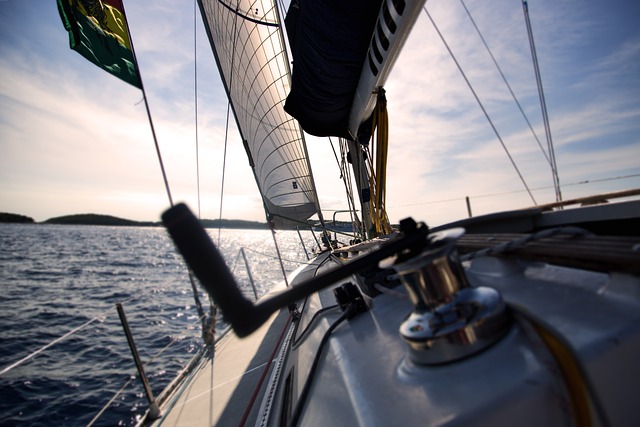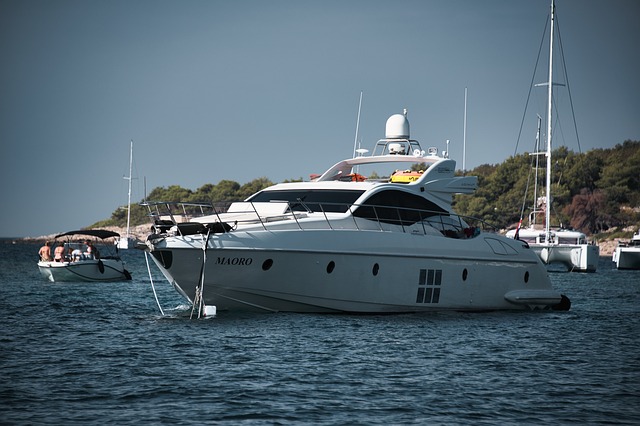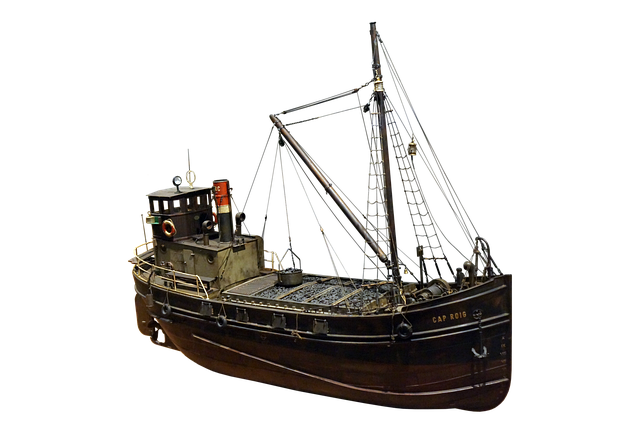Marine batteries are specialized for deep-cycle use and require specific maintenance practices to ensure their longevity and optimal performance. Regular health checks include monitoring voltage, specific gravity, electrolyte levels, and looking out for terminal corrosion. Proper charging tailored to marine battery types is essential, with the right charger for lead-acid, AGM, or lithium ion batteries to resist saltwater exposure and vibrations. Storage in a temperate environment with a partial charge is recommended when not in use. Upkeep involves routine cleaning, electrolyte checks, and maintaining the correct charge level to prevent premature aging or failure. Environmental factors like temperature extremes must be managed to maintain battery function. For enhanced performance, consider upgrading to larger capacity batteries or parallel systems to support higher electrical demands. Utilize smart battery monitors for real-time insights into your marine battery's status and adjust your maintenance routine to preemptively address potential issues, ensuring a reliable power source for all your maritime activities.
navigating the complexities of marine battery performance can be a pivotal aspect of maintaining your vessel’s efficiency and reliability. This article delves into the essential practices for diagnosing and rectifying issues that may affect your marine battery’s functionality. From assessing its health to understanding the intricacies of different types of marine batteries and their roles, we provide a comprehensive guide on proper charging techniques, the importance of maintenance, and effective troubleshooting strategies. Additionally, learn how upgrading your system can enhance both reliability and power output for an optimized boating experience.
- Assessing the Health of Your Marine Battery
- Understanding Marine Battery Types and Their Functions
- Proper Charging Techniques for Optimal Marine Battery Performance
- The Role of Maintenance in Maintaining Marine Battery Efficiency
- Troubleshooting Common Issues Affecting Marine Battery Life
- Upgrading Your Marine Battery System for Enhanced Reliability and Power
Assessing the Health of Your Marine Battery

When confronted with performance issues in your marine battery, the first step is to conduct a thorough assessment of its health. This involves checking the voltage and specific gravity levels of each cell, as a significant drop can indicate sulfation or a weakened battery. Regularly monitor the electrolyte levels to ensure they are at the proper concentration; low electrolyte levels can lead to poor battery performance. Additionally, inspect the battery terminals and connections for any signs of corrosion, which can impede electrical flow and cause the battery to underperform. Ensure that the battery is properly secured and that all terminals are tight to prevent any loose connections that could disrupt power supply. It’s also crucial to pay attention to the charging system; an improper charging regimen can compromise the health of your marine battery over time. By regularly performing these checks, you can proactively address potential issues before they significantly impact your vessel’s power systems, thereby maintaining optimal performance and longevity for your marine battery. Regular maintenance and understanding how to correctly handle and store your marine battery are key components in preserving its efficiency and ensuring it operates at peak capacity on the water.
Understanding Marine Battery Types and Their Functions

When addressing performance issues with marine batteries, a foundational understanding of the different types and their functions is crucial. Marine batteries are specifically designed to endure the harsh conditions of maritime environments, which sets them apart from standard automotive or deep-cycle batteries. There are primarily two main types of marine batteries: starting (or cranking) batteries and deep-cycle batteries. Starting batteries are engineered to deliver high bursts of energy for starting motors, even under cold conditions. They typically have a higher ampere hour (Ah) rating than their deep-cycle counterparts due to the thicker plates that store less energy but can deliver power at a higher rate.
On the other hand, deep-cycle batteries are designed with thinner plates and are optimized for cyclic use, such as powering trolling motors or providing steady power for electronic devices over extended periods. These batteries are built to handle multiple discharge and recharge cycles without a significant drop in performance. Understanding the role each type plays is essential for selecting the right battery for specific applications onboard a vessel. Proper maintenance, including regular cleaning, topping off electrolyte levels, and ensuring correct charge levels, is necessary to maintain optimal performance from these critical components of your marine system. Knowledge of these distinctions can help mariners effectively troubleshoot and enhance the performance of their marine batteries.
Proper Charging Techniques for Optimal Marine Battery Performance

To maintain optimal performance from your marine battery, it’s crucial to employ proper charging techniques. Unlike automotive batteries, marine batteries are designed for deep-cycle applications, which means they can withstand frequent discharges and replenishments. A key aspect of maintaining their health is to charge them at a rate that aligns with their capacity. This involves selecting the right charger for the battery type—whether it’s lead-acid, AGM, or lithium ion—and ensuring it provides a stable output voltage within the manufacturer’s specifications. Proper charging also entails using a charger designed specifically for marine batteries, as these are tailored to handle the harsh saltwater environment and vibrations commonly encountered at sea. Regularly monitoring the battery’s charge level and state of health will prevent premature aging or failure, ensuring your marine battery delivers reliable power when you need it most, whether for trolling or navigating open waters. Additionally, storing your marine battery in a cool, dry place with a partial charge when not in use can further extend its lifespan and keep it ready for your next adventure on the water.
The Role of Maintenance in Maintaining Marine Battery Efficiency

Regular maintenance is a cornerstone in preserving the efficiency of your marine battery. These batteries, which are specifically designed to withstand the harsh conditions found at sea, still require consistent care to ensure they perform optimally. Over time, saltwater exposure, temperature fluctuations, and the deep discharge cycles typical in marine applications can take a toll on a marine battery’s performance. To combat these challenges, it’s imperative to regularly check and clean the battery terminals and connections, as corrosion can significantly impede electrical flow. Keeping the terminals free of debris and tightly secured is a simple yet effective way to maintain battery efficiency.
Furthermore, monitoring the water levels in flooded-type marine batteries is crucial for their longevity. The electrolyte solution must be at the correct specific gravity, as both overfilling and underfilling can lead to reduced capacity and shorter battery life. Regularly checking the charge level with a reliable voltmeter or a hydrometer is also a key aspect of maintenance. If the battery falls below its recommended operational voltage or electrolyte concentration for an extended period, it may suffer from sulfation, which can impair its ability to hold a charge. By adhering to a diligent maintenance schedule and addressing any issues promptly, you can ensure your marine battery continues to deliver the reliable power needed for all your nautical adventures.
Troubleshooting Common Issues Affecting Marine Battery Life

When facing performance issues with a marine battery, it’s crucial to systematically identify and address common problems that can affect its lifespan. One of the primary issues is sulfation, where sulfur crystals form on the battery plates, leading to reduced efficiency and voltage output over time. Regular cleaning and maintenance can help prevent this by ensuring optimal conductivity between the plates and the electrolyte solution. Another frequent concern is overcharging, which can cause excessive gassing and heat buildup, potentially shortening the battery’s life. Monitoring charge levels and using a reliable charging system designed for marine batteries can mitigate this risk.
In addition to sulfation and overcharging, it’s essential to check for loose or corroded connections. These can significantly impede current flow and cause false readings on battery meters. Ensuring all terminals are tight and free from corrosion is a straightforward yet effective way to enhance performance. Additionally, the state of charge (SOC) should be regularly monitored; letting a marine battery discharge completely can damage its cells, leading to poor hold and reduced capacity. Regular charging and not allowing the battery to deep discharge are key practices in maintaining its health. Lastly, the temperature is a significant factor affecting marine batteries. Operating in extreme temperatures can degrade the battery’s performance. Therefore, it’s advisable to insulate the battery from extreme conditions as much as possible and consider a heated enclosure for colder environments to ensure the marine battery operates at its peak efficiency.
Upgrading Your Marine Battery System for Enhanced Reliability and Power

When addressing performance issues with your marine battery system, considering an upgrade can significantly enhance both reliability and power output. Upgrading to a larger capacity marine battery or adding additional batteries in parallel can provide more ampere-hours and greater stability for your onboard electrical needs. This not only ensures that you have enough power for your devices but also prevents the discharge of one battery going too low, which could potentially damage it. Choosing high-quality marine batteries is crucial for optimal performance; these are designed to withstand the harsh marine environment, offering a longer lifespan and better charge retention compared to standard automotive batteries. Additionally, assessing and improving your battery’s connection points can also lead to noticeable improvements. Clean and tighten all terminals and cables to eliminate any potential voltage loss due to poor connections. Proper maintenance and periodic inspections of your marine battery system will help you detect and correct issues early, thus safeguarding against unexpected power failures during your time out on the water. Upgrading to a smart battery monitor can also provide valuable data on your battery’s health and usage patterns, allowing for more informed decisions regarding your marine battery setup.
When addressing performance issues with your marine battery, a comprehensive approach is key. Begin by thoroughly assessing its health, understanding the distinct roles of different marine battery types, and ensuring you employ proper charging techniques. Regular maintenance plays an indispensable role in preserving efficiency, while staying vigilant to common issues can extend your battery’s lifespan. For those seeking enhanced performance, upgrading your marine battery system may be a prudent step. By adhering to these guidelines and best practices, you can effectively resolve performance problems and maintain the dependable power necessary for all your maritime adventures.
